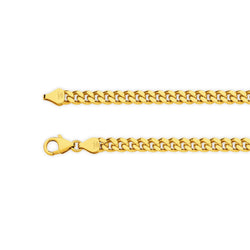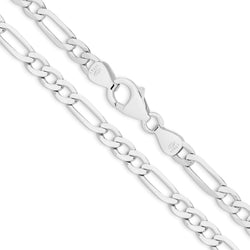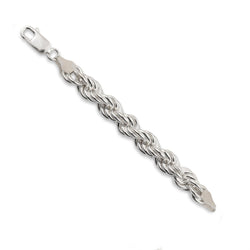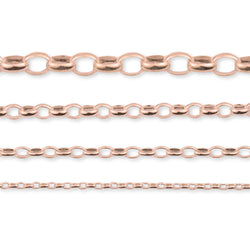Chain
Jewellery Making Chains
Chains are the cornerstone of fine jewellery, offering both functional and aesthetic value to elevate every creation. Whether you're designing bespoke necklaces, elegant ear cuffs, modern bracelets, or other custom pieces, the right chain adds sophistication, durability, and visual harmony to your designs. At Ore Metals, we provide an extensive collection of high-end jewellery-making chains in various styles and materials, catering to everything from large-scale projects to exclusive, bespoke creations.
Loose Chain Rolls for Bespoke Creations
For jewellers and artisans focused on crafting custom or one-of-a-kind designs, our loose chain rolls offer unparalleled flexibility. Available in luxurious styles such as Snake, Wheat, Figaro, Singapore Twist, and Paperclip, these rolls enable you to craft bespoke necklaces, bracelets, anklets, and even permanent jewellery. Their adaptability ensures you can cut and assemble chains to the exact length and style specifications your project demands. Perfect for creating high-end soldered jewellery or adding ornamental details, our loose chain rolls in 9ct and 18ct yellow, white, and rose gold, sterling silver, platinum, and gold-filled options provide the ultimate canvas for your artistry.
Finished Necklace Chains for Stunning Designs
Elevate your jewellery line with our selection of finished necklace chains, designed for effortless luxury. Choose from intricate Belcher patterns, bold Cuban Links, or timeless Snake and Cable chains. Each necklace is expertly crafted to be durable yet elegant, providing the perfect platform for showcasing pendants, charms, or standing alone as a sophisticated accessory. Available in premium materials, including solid gold, sterling silver, and other exotic alloys on request, these finished necklace chains add refined craftsmanship to any jewellery collection.
Bracelet Chains for Signature Pieces
Create unforgettable bracelet designs with our collection of luxurious bracelet chains. Whether you prefer the bold style of the Curb chain, the contemporary edge of Paperclip links, or the classic appeal of the Cable chain, our options ensure both durability and sophistication. Perfect for adding gemstones, charms, or other embellishments, these bracelet chains offer the ideal foundation for pieces that are both stylish and long-lasting. With options in solid 9ct and 18ct gold, sterling silver, and platinum, these chains are designed to impress.
Chain Extenders for Custom Fit
Our chain extenders, crafted from solid gold and sterling silver, are the ultimate tool for tailoring jewellery to fit flawlessly. Whether you're adjusting the length of a necklace, bracelet, or anklet, these extenders provide a seamless solution for creating layered looks or accommodating diverse preferences. With their elegant design and exceptional quality, chain extenders enhance both the comfort and versatility of your jewellery, making them a must-have for any high-end collection.
Versatility of Chain Styles in Jewelry Design
Our collection spans a wide range of luxurious chain styles, ensuring you can find the perfect match for any jewellery piece. Sleek Snake and Singapore Twist chains bring modern sophistication, while Figaro and Paperclip chains add bold, contemporary flair. Classic styles like Wheat, Belcher, Cuban, and Curb chains embody timeless elegance, while Platinum and 18ct gold options elevate designs to the pinnacle of fine jewellery. Each style has been selected for its ability to complement premium designs, making our chains an essential resource for jewellers who demand quality and style.
Explore our collection today and find the perfect chain to transform your jewellery into masterpieces of enduring luxury.
Frequently Asked Questions
A good necklace chain possesses strength, quality material, and an appropriate clasp.
It should be well-constructed with uniform links, ensuring it can withstand regular wear without breaking.
The material, whether gold, sterling silver, should be hypoallergenic and maintain its lustre over time.
The clasp, too, must be secure and easy to operate, while matching the chain's style for a seamless look.
High-quality chains are identifiable by their uniform and smooth links, secure clasps, and sturdy construction that resists kinking and breakage.
They should have a hallmark stamp indicating the metal purity, such as "925" for sterling silver or "9ct" or "375" for 9-carat gold.
The chain should feel substantial in weight relative to its size and should not show any signs of plating wear or discoloration after use.
Understanding the differences between solid gold, gold vermeil, and gold plated jewellery is crucial for both makers and buyers, as it impacts the piece's aesthetic, price point, and longevity.
- Solid Gold: Solid gold jewellery is made of gold throughout, not just on the surface. It's the most expensive and high-quality option available, resistant to rust, tarnish, and corrosion. Solid gold's value and durability make it an heirloom choice, meant to last and be worn for generations.
- Gold Vermeil (pronounced 'ver-may'): This is a form of gold plating. To be considered vermeil, the jewellery must have a sterling silver base and be coated with a layer of gold, usually 10K or higher. The layer of gold is thicker than the one used in gold plating, typically at least 2.5 microns.
- Gold Filled: Gold filled jewellery involves bonding a layer of gold, typically 5% or 1/20 of the total weight, to a base metal like brass. Bonding using this processes compared to plating results in a longer lasting lustre compared to Gold vermeil, however due to the nature of gold filled materials, smaller scratches and other damage can be more difficult if not impossible to repair.
Making chains can be broken down into two categories: Finishing machine made chains or handmade chains
With machine made styles, making jewellery chains involves selecting the desired material and style, cutting the chain to length, and adding any necessary components like end caps, clasps & jump rings.
For handmade chains, you will form and solder individual links, a process that requires metalworking tools and skills. Whether creating simple linked chains or intricate patterns, precision and patience are key.
The best chains for jewellery making projects depend on the type of jewellery you’re creating. For necklaces, Wheat and Snake chains are popular due to their intricate patterns and smooth texture. For bracelets, Cuban link and Curb chains are durable and stylish choices. If you need a versatile option, Figaro and Cable chains work well for both necklaces and bracelets. For custom projects, using chain rolls allows you to tailor the chain length and style to your specific design needs.
Choosing the right chain style for custom jewellery involves considering the overall design and purpose of the piece. For a classic and elegant look, Singapore Twist, Wheat or Figaro chains are ideal. If you want a more modern and bold design, Paperclip or Cuban link chains are great options. For delicate designs, a Snake or Belcher chain might be best. Additionally, consider the thickness and durability of the chain, especially if you plan to add pendants or charms.
A Wheat chain features intricate, intertwined links that create a textured, braided appearance, offering both flexibility and strength. A Figaro chain, on the other hand, consists of a pattern of short and long links, typically with one long link followed by one, two or three shorter links. Wheat chains are known for their elegant and sophisticated look, while Figaro chains are more classic and versatile, making them suitable for both men’s and women’s jewellery.
"Diamond Cut" refers to a specific technique used in the manufacturing of chains where the surface of the metal links is precisely cut with a diamond-tipped tool. This process creates sharp, flat facets on the links, giving the chain a highly reflective and sparkling appearance. The "diamond cut" enhances the chain’s shine and brilliance, making it appear more luxurious and eye-catching. This finish is commonly applied to various chain styles, such as Long Curb, Curb, and Figaro chains, to add extra visual appeal and elegance.
Yes, Solid gold and sterling silver chains are the highly resistant to water. However, Prolonged exposure to water, especially chlorinated or salt water, can lead to tarnishing in sterling silver and might slightly dull the finish on gold over time.
Yes, solid gold bracelet chains are highly durable and suitable for everyday wear. Gold is a naturally durable metal, and when used in bracelet chains, it resists tarnishing and corrosion. For daily wear, it’s best to choose a gold bracelet with a sturdy link style, such as a Cuban link or Curb chain, which can withstand regular use without losing its integrity.
To use chain extenders to customise necklace length, simply attach the extender to the end of your necklace chain using the clasp. An additional clasp may be required if the design of the necklace doesn't accommodate additional links. Chain extenders allow you to adjust the necklace to the desired length for layering or achieving the perfect fit. Extenders are available in matching various alloys like sterling silver or yellow, white and rose gold to blend seamlessly with your necklace.
Sterling silver chains offer several benefits, including a beautiful, bright lustre that complements various gemstones and pendants. Sterling silver is also hypoallergenic, making it a great option for those with sensitive skin. Additionally, it is durable and easy to maintain, ensuring that your necklace retains its shine and appearance over time.
Yes, you can solder permanent jewellery chains at home, but it requires the right tools and experience. You will need a Micro welder or a soldering kit, which includes a torch, flux, solder, and other essential tools. Permanent jewellery, such as soldered chains, requires precision and safety measures. If you are new to soldering, it’s advisable to practise on scrap pieces first.
The most popular chain styles for necklaces include the Wheat chain, known for its intricate and elegant design; the Paperclip chain, favoured for its modern, minimalist look; and the Snake chain, prized for its smooth and sleek appearance. Other popular styles include the Figaro chain, with its alternating link pattern, and the Cable chain, which offers a simple and classic aesthetic.
When selecting a chain for heavy pendants, choose a chain that is strong and durable, such as a Curb or Cuban link chain. These chains have thicker, closely connected links that can support the weight of a heavy pendant without breaking or distorting. Ensure that the chain’s clasp is also robust to securely hold the pendant in place.
The best chain style for making custom bracelets depends on the desired look and durability. Cuban link and Curb chains are excellent for creating bold, durable bracelets that can be worn daily. For a more delicate and elegant look, a Cable or Wheat chain works well. Belcher chains are also popular for their simple yet strong design, making them versatile for various bracelet styles.
To attach a clasp to a loose chain roll, cut the chain to your desired length and use jump rings to connect the clasp to each end of the chain. Use flat-nose pliers to securely close the jump rings, ensuring the clasp is firmly attached. For added security, solder the jump rings closed to prevent them from opening during wear. Alternatively, Link Locks or Split Rings can be used as solder-free permanent or semi-permanent solutions.
A Cuban link chain features thick, interlocking oval links that lie flat and closely together, making it one of the most durable and heavy-duty chain styles. A Curb chain, while similar, has thinner, more uniform links that are often slightly twisted to lie flat. Both chains are popular for their strength and classic appearance, but the Cuban link chain is generally chunkier and more robust.
Yes, our gold chain extenders are available in custom lengths. These extenders allow you to adjust the length of your necklaces or bracelets to achieve the perfect fit or style.
To care for and maintain your Sterling silver chains, regularly clean them with a soft cloth to remove tarnish and oils. Store your silver chains in a dry, airtight container or anti-tarnish pouch to prevent oxidation. Avoid exposing your chains to harsh chemicals, such as chlorine or bleach.
Jewellery saw or cutters: For cutting the chain to the desired length.
Flat-nose pliers: For opening and closing jump rings.
Round-nose pliers: For shaping wire and making loops.
Soldering kit: If you plan to permanently solder the chain links or attach clasps securely.
These tools will help you efficiently create custom necklaces, bracelets, and other jewellery pieces from chain rolls.
Cable chains offer several advantages in jewellery making, including their simple yet durable design. The uniform links of Cable chains provide a classic look that pairs well with various pendants and charms. They are also versatile, available in various thicknesses, and can be used for necklaces, bracelets, and anklets. Cable chains are easy to work with, making them a popular choice for both beginners and experienced jewellers.
Yes, combining different chain styles in one jewellery piece can create a unique and eye-catching design. For example, you can mix a delicate paperclip chain with a bold Cuban link chain for a layered necklace look. Combining different textures and weights of chains adds dimension and interest to your jewellery, allowing you to create custom, statement pieces.
The best way to store loose jewellery chains is to keep them stored individually in small plastic bags or in a jewellery box. This prevents the chains from tangling and protects them from dust and moisture. If storing for a long period, consider using anti-tarnish strips or storing them in an airtight container to prevent oxidation.
To determine the right length for a custom necklace chain, consider the wearer’s neck size, the pendant size, and the desired placement on the chest. Common lengths include 16 inches (choker), 18 inches (standard), and 24 inches (long necklace). Use a soft measuring tape around the neck to gauge the correct length, and take into account the necklace style and layering preferences.
Belcher chains have uniform, round or oval links which are fabricated from wire with a half round profile, giving them a traditional and slightly chunky appearance. Cable chains, on the other hand, have uniform, round links that create a smooth, classic look. Belcher chains are often used for heavier pendants due to their robust structure, while Cable chains are more delicate and versatile for various jewellery designs.
Yes, chain extenders can be used with most types of necklaces, including Cable, Curb, Figaro, and Paperclip chains.
The most durable chain styles for bracelet making include Cuban link, Curb, and Cable chains. These chains feature thick, interlocking links that are resistant to breaking and can withstand daily wear. Cuban link chains are particularly robust, making them a popular choice for men’s bracelets, while Curb and Cable chains offer a slightly lighter, yet still durable, option suitable for both men’s and women’s bracelets, necklaces, anklets and embellishments.
To incorporate Snake chains into minimalist jewellery designs, use the chain as the main focus by pairing it with simple, sleek pendants or wearing it alone for a clean, modern look. The smooth, fluid appearance of Snake chains makes them ideal for minimalist styles, where the focus is on the elegance of the chain itself. Opt for thinner Snake chains for a subtle effect or thicker ones for a bolder statement while keeping other design elements minimal.
Using solid gold and silver chains in jewellery making offers several benefits, including increased durability, a more polished appearance, and long-lasting wear. Solid gold and silver chains resist tarnishing and breaking, ensuring that your jewellery maintains its beauty over time. They also provide a secure foundation for pendants, charms, and other embellishments, which enhances the overall quality of your jewellery pieces. Investing in premium materials helps create pieces that customers will value and trust.
To create a layered necklace look using different chain styles, start by selecting chains of varying lengths, thicknesses, and textures. For example, pair a delicate Wheat chain with a bold Cuban link chain and a medium-length Paperclip chain. Ensure that each chain complements the others without overwhelming the overall look. Layer the chains from shortest to longest, and mix metals or add pendants to some of the chains for added interest and depth. The key is to balance contrast and harmony for a cohesive yet dynamic layered look.
You can buy jewellery making chain rolls online from specialised jewellery supply stores like Ore Metals, which offer a wide selection of chain styles. We provide high-quality chain rolls in sterling silver and gold, allowing you to purchase the exact amount needed for your custom jewellery projects.
The best chain to wear daily is one that is durable, comfortable, and versatile. Cuban link and Curb chains are excellent choices for daily wear due to their strength and classic style. Cable chains are also a good option, especially if you prefer a more delicate look. Choose chains made from solid gold, sterling silver, or stainless steel for daily wear, as these materials are resistant to tarnishing and can withstand regular use.
Yes, a real gold chain is worth the investment for its durability, timeless beauty, and intrinsic value. Real gold chains do not tarnish or corrode, making them ideal for long-term wear. They also retain their value over time and can be passed down as heirlooms. While the initial cost may be higher than gold-plated or costume jewellery, the longevity and quality of a real gold chain make it a worthwhile purchase for anyone looking for a lasting and valuable piece of jewellery.




